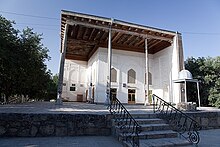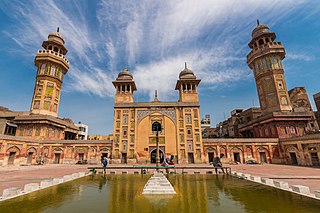
The Wazir Khan Mosque is a 17th-century mosque located in the city of Lahore, capital of the Pakistani province of Punjab. The mosque was commissioned during the reign of the Mughal Emperor Shah Jahan as a part of an ensemble of buildings that also included the nearby Shahi Hammam baths. Construction of Wazir Khan Mosque began in 1634 C.E., and was completed in 1641. It is on the UNESCO World Heritage Tentative List.

Shakhrisabz is a district-level city in Qashqadaryo Region in southern Uzbekistan. It is located approximately 80 km south of Samarkand, at an altitude of 622 m. Its population is 140,500 (2021). Historically known as Kesh or Kish, Shahrisabz was once a major city of Central Asia and was an important urban center of Sogdiana, a province of the Achaemenid Empire of Persia. It is primarily known today as the birthplace of 14th-century Turco-Mongol conqueror Timur.
Namangan is a city in eastern Uzbekistan. It is the administrative, economic, and cultural center of Namangan Region. Administratively, it is a district-level city. Namangan is located in the northern edge of the Fergana Valley, less than 30 km from the Kyrgyzstan border. The city is served by Namangan Airport.
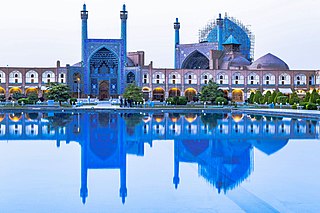
The Shah Mosque is a mosque located in Isfahan, Iran. It is located on the south side of Naghsh-e Jahan Square. It was built during the Safavid dynasty under the order of Shah Abbas I of Persia.

An iwan is a rectangular hall or space, usually vaulted, walled on three sides, with one end entirely open. The formal gateway to the iwan is called pishtaq, a Persian term for a portal projecting from the facade of a building, usually decorated with calligraphy bands, glazed tilework, and geometric designs. Since the definition allows for some interpretation, the overall forms and characteristics can vary greatly in terms of scale, material, or decoration.

The Sixty Dome Mosque, is a mosque in Bagerhat, Bangladesh. It is a part of the Mosque City of Bagerhat, a UNESCO World Heritage Site. It is the largest mosque in Bangladesh from the sultanate period (1352–1576). It was built during the Bengal Sultanate by Khan Jahan Ali, the governor of the Sundarbans. It has been described as "one of the most impressive Muslim monuments in the whole of South Asia."

The Bibi-Khanym Mosque is one of the most important monuments of Samarkand, Uzbekistan. In the 15th century, it was one of the largest and most magnificent mosques in the Islamic world. It is considered a masterpiece of the Timurid Renaissance. By the mid-20th century, only a grandiose ruin of it still survived, but major parts of the mosque were restored during the Soviet period.

The Green Mosque, also known as the Mosque of Mehmed I, is a part of a larger complex on the east side of Bursa, Turkey, the former capital of the Ottoman Turks before they captured Constantinople in 1453. The complex consists of a mosque, türbe, madrasah, kitchen and bath. The name Green Mosque comes from its green and blue interior tile decorations.

The Jāmeh Mosque of Isfahān or Jāme' Mosque of Isfahān, also known as the Atiq Mosque and the Friday Mosque of Isfahān, is a historic congregational mosque (Jāmeh) of Isfahan, Iran. The mosque is the result of continual construction, reconstruction, additions and renovations on the site from around 771 to the end of the 20th century. The Grand Bazaar of Isfahan can be found towards the southwest wing of the mosque. It has been a UNESCO World Heritage Site since 2012. It is one of the largest and most important monuments of Islamic architecture in Iran.

The Shah Jahan Mosque, also known as the Jamia Masjid of Thatta, is a 17th-century building that serves as the central mosque for the city of Thatta, in the Pakistani province of Sindh. The mosque is considered to have the most elaborate display of tile work in South Asia, and is also notable for its geometric brick work - a decorative element that is unusual for Mughal-period mosques. It was built during the reign of Mughal emperor Shah Jahan, who bestowed it to the city as a token of gratitude, and is heavily influenced by Central Asian architecture - a reflection of Shah Jahan's campaigns near Samarkand shortly before the mosque was designed.

Haj Shahbazkhan Mosque is a mosque located in the Ojagh Crossroads of Kermanshah, Iran.

The Jama Mosque is a 17th-century congregational mosque located in the historic core of Agra, Uttar Pradesh. It was built by Jahanara Begum, Padshah Begum of the Mughal Empire, during the reign of her father, Mughal Emperor Shah Jahan. It is one of the largest mosques in India. Today it is still in use, serving as the principal mosque for the city of Agra. It stands opposite to the Agra Fort, and overlooks the Agra Fort Railway Station.

The Great Mosque of Herat or "Jami Masjid of Herat", is a mosque in the city of Herat, in the Herat Province of north-western Afghanistan. It was built by the Ghurids, under the rule of Sultan Ghiyath al-Din Muhammad Ghori, who laid its foundation in 1200 CE. Later, it was extended several times as Herat changed rulers down the centuries from the Kartids, Timurids, Mughals and then the Uzbeks, all of whom supported the mosque. The fundamental structure of the mosque from the Ghurid period has been preserved, but parts have been added and modified. The Friday Mosque in Herat was given its present appearance during the 20th century.

Ak Mosque is a 19th century mosque in Khiva, Uzbekistan. It stands in Itchan Kala, the walled old city of Khiva, which is a World Heritage Site. It was built between 1838 and 1842 on older foundations. It consists of a square, domed room, surrounded on three sides by a portico (iwan). Its total size is 25.5 x 13.5 m.

The Vakil Mosque is a mosque in Shiraz, southern Iran, situated to the west of the Vakil Bazaar next to its entrance. This mosque was built between 1751 and 1773, during the Zand period; however, it was restored in the 19th century during the Qajar period. Vakil means regent, which was the title used by Karim Khan, the founder of Zand Dynasty. Shiraz was the seat of Karim Khan's government and he endowed many buildings, including this mosque.
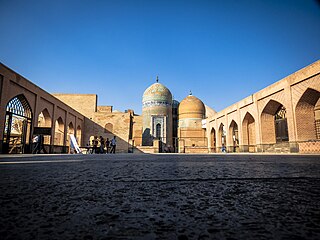
Sheikh Safi al-Din Khānegāh and Shrine Ensemble is the tomb of Sheikh Safi-ad-din Ardabili located in Ardabil, Iran. In 2010, it was registered on the UNESCO World Heritage List. This monument is situated in the Ali-Ghapu area.

The Sultan Al-Ghuri Complex or Funerary complex of Sultan al-Ghuri, also known as al-Ghuriya, is a monumental Islamic religious and funerary complex built by Sultan Qansuh al-Ghuri between 1503 and 1505 CE. The complex consists of two major buildings facing each other on al-Mu'izz li-Din Allah street, in the Fahhamin Quarter, in the middle of the historic part of Cairo, Egypt. The eastern side of the complex includes the Sultan's mausoleum, a khanqah, a sabil, and a kuttab, while the western side of the complex is a mosque and madrasa. Today the mosque-madrasa is still open as a mosque while the khanqah-mausoleum is open to visitors as a historic site.
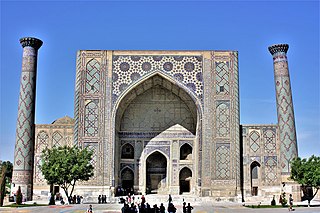
The Ulugh Beg Madrasa is a madrasa in the historic center of Samarkand, a UNESCO World Heritage Site in Uzbekistan. Together with other monuments, it forms the monumental ensemble of Registan, the old heart of the city. It was built between 1417 and 1421 by the then-Timurid governor of Samarkand, Ulugh Beg, Timur's grandson and prominent astronomer, who was later emperor between 1447 and 1449.

Bolo Haouz Mosque is a historical mosque in Bukhara, Uzbekistan. Built in 1712, on the opposite side of the citadel of Ark in Registan district, it is inscribed in the UNESCO World Heritage Site list along with the other parts of the historic city. It served as a Friday mosque during the time when the emir of Bukhara was being subjugated under the Bolshevik Russian rule in the 1920s. Thin columns made of painted wood were added to the frontal part of the iwan (entrance) in 1917, additionally supporting the bulged roof of summer prayer room. The columns are decorated with colored muqarnas.

Maghoki Attori Mosque is a historical mosque in Bukhara, Uzbekistan. It forms a part of the historical religious complex of Lyab-i Hauz. The mosque is located in the historical center of Bukhara, about 300 meters southwest of Po-i-Kalyan, 100 meters southwest of the Toqi Telpak Furushon trading dome and 100 meters east of Lab-i Hauz. It is a part of UNESCO World Heritage Site Historic Centre of Bukhara. Today, the mosque is used as a carpet museum.
